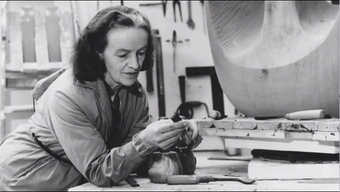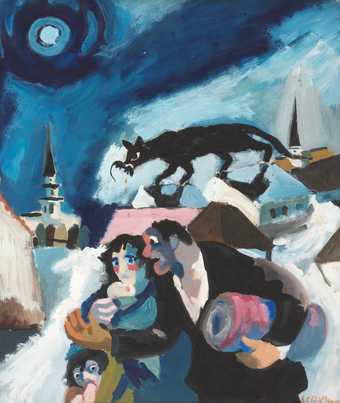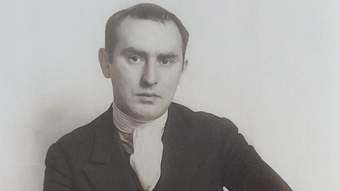Annabel Hodin: I think he was comfortable in the world of the mind and excellence and I think that his friendships were the most important things.
Alexandra Lazar: So, Joseph Paul Hodin was an art historian, a writer, poet, artist, art historian and critic, philosopher. He grew up in early 20th century Prague. He was dedicated to reading and poetry and wanted to become an artist.
AH: Well I'm the daughter of J.P. Hodin. He definitely didn't want to stay in the Prague he loved, he wanted to explore because of the books and the literature and the thirst for knowledge and other experiences.
AL: His family stayed in Prague. Several futile attempts were made to get them out of Prague and to get him to immigrate and they wrote heartbreaking letters to each other. His family was taken to Theresienstadt and perished.
AH: I think having your own home for that was very important having been displaced in five countries there was a family stability, you know, he would take us for evening walks and bash the hedges for badgers and frightening stories to go to bed. Everything was a celebration of seasons, a celebration of the important moments in a year.
Andrew Stahl: I think this was very much his home surrounded by his paintings and you know the lovely garden and lots of different works, a lot of the works of the artists he supported. From a young age I actually wanted to be an astronaut because everyone was landing on the moon and doing this and that, so I did Science A-Levels. I did art as a side subject because there was no homework with it. When he came over for a strawberry party I took him up to my bedroom where all these paintings were. He was so excited and supportive and he said wow keep going, yes you must look at this, look at that and I know he really looked after a lot of artists that came here as well.
AH: He tried to find what was his role in England and he saw that post-war there was no knowledge of European art or expressionism. The whole thing of the émigré artists they were here but they were unknown and he wanted to make sure that the émigré artists here had some way of being seen.
AL: Being fluent in four languages and kind of writing in seven languages he was writing, he was opening up the world of British art and especially the Cornish art scene for example to the continent. So he was writing about all these artists and introducing them in the context where they were mostly unknown.
AS: He wrote books on Henry Moore, Ben Nicholson, Barbara Hepworth and even Bernard Leach.
AH: The St Ives group were ready to fly, he could see here there were artists who would be welcomed abroad
AL: Hodin was a bonafide art historian but he also believed that art of its time needs to speak about its time/ He never wrote about an artist that he didn't know personally. So some of the key artists in his life remained throughout his life. Oskar Kokoschka for example he met, they became friends and they remained friends throughout Kokoschka's stay in England. And then later when he moved and lived in Switzerland, Hodin went and spent months at a time living and writing about him.
AH: The fact that he actually could describe Kafka and talk about him and talk to him and met him, and Munch and all those people that he went in search of made him completely different because he had spoken to and met everyone he wrote about and not just on a superficial level.
AL: He was also an incredible student of philosophy and history and art history, so he was able to bring all that all this expanded knowledge into his writing about art. So when he was writing about contemporary artists he would kind of reference arts from the Antiquity from the Byzantium period from the Gothic he really found ways to write about art through parallels, through comparison, through making connections.
AS: I mean a thing for me that he introduced is the importance that painting has feeling. I remember him saying you don't have to explain everything, you can invent.
AH: As a father what was wonderful was his curiosity and his wish to impart and share knowledge with us. I suppose I didn't really differentiate between the working man and what he stood for and the father because he didn't really put that barrier down. What it was was throughout our family life and throughout his working life there was a modesty and an integrity and strong values of connections and communication and love, actually and laughter.
Art historian J.P. Hodin was friend and supporter to some of Europe's most important artists and thinkers, such as Franz Kafka, Barbara Hepworth and Oskar Kokoschka.
An émigré from Prague who spoke four languages fluently, and wrote in seven, he was responsible for introducing many European cultural figures to British audiences, and for opening up movements in the British art world, like the St Ives scene, to the continent.
In this film, his daughter Annabel Hodin, writer and curator Alexandra Lazar and artist Andrew Stahl recount the life of this fascinating figure.



